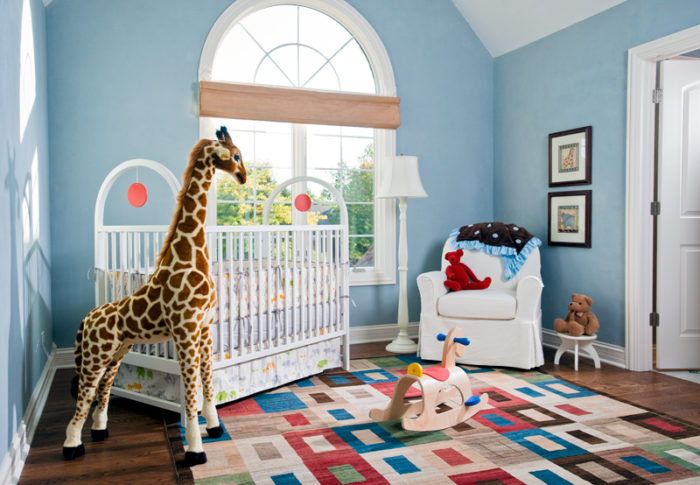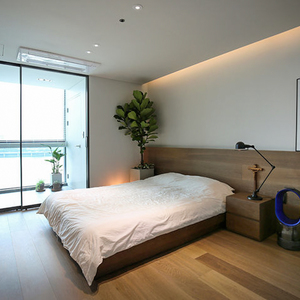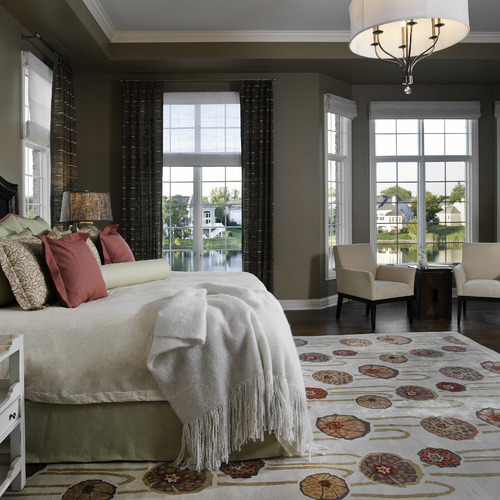To create healthy and sustainable interiors for our clients, it is essential that we understand how to enhance indoor air quality, tapping into IAQ-specific resources and expertise. GREENGUARD Environmental Institute (GEI) is at the top of my resource list.
Recently I had the opportunity to interview Leslie Gage, market segment manager for GREENGUARD. Leslie is GEI’s in-house architectural consultant and sustainable design expert guiding the outreach and education efforts to communities such as architecture and design, construction, and schools. She is also a LEED advocate and specifications author for enhanced indoor air quality in buildings.
Annette: Leslie, what is the GREENGUARD Environmental Institute’s focus?
Leslie: The GREENGUARD Environmental Institute aims to protect human health and improve quality of life by enhancing indoor air quality and reducing people’s exposure to chemicals and other pollutants. As an ISO-IEC Guide 65:1996 accredited, third-party organization, the GREENGUARD Environmental Institute certifies products and materials for low chemical emissions and provides a resource for choosing healthier products and materials for indoor environments. All certified products must meet stringent chemical emissions standards based on established criteria from key public health agencies. GREENGUARD Certification is broadly recognized and accepted by sustainable building programs and building codes worldwide.
Annette: Why is the HH10 significant to the future of healthy, sustainable residential interiors?
Leslie: Healthy Home 2010 is a significant contribution to our understanding of sustainability as a whole. I think a lot of homeowners and consumers out there think that green equals healthy. Actually, that’s not always the case. Right now, there are so many different attributes that contribute to sustainable design that often some of the most important aspects, like health, are overlooked. If chemicals in the air we breathe have the potential to make us sniffle, give us a headache, or even trigger an asthma attack, do we really want our families to spend the majority of their days in an environment brimming with airborne chemicals? And yet, in most green building programs, achieving good indoor air quality is merely an “extra point,” or option, for sustainability. Why is that?
The fact is, if our homes don’t have good indoor air quality, then we don’t function well inside them. The Healthy Home 2010 project team gets this. They made indoor air quality one of their top priorities and incorporated elements of the GREENGUARD IEQ Management Plan for Residential Construction, which outlined step-by-step processes for improving the home’s indoor air quality. They also specified many GREENGUARD Certified low-emitting materials. So, not only did they follow the LEED for Homes guidelines for energy and water conservation, site selection, and material use, but they also made a concerted effort to enhance the home’s indoor air quality.
It’s been a process, and it wasn’t easy. But I think we, as a society, are starting to really grasp how extremely important human health is as a core component of sustainable, “green” homes.
Annette: How does this project bridge the gap between green construction and healthy interiors?
Leslie: I think it’s really tempting for society as a whole to oversimplify and boil down the concept of sustainability into one word: green. But what does that really mean?
Unfortunately, there’s so much confusion in the marketplace about what green really means and whether green always equals healthy. In fact, green does not always equal healthy. A green product may have some degree of benefit to the planet or the outdoor environment while having a negative impact on our indoor environment and, subsequently, our health. For example, sometimes sealing up our homes to save energy can have a detrimental effect on our indoor air quality simply because there is no way for air pollutants to get out of the house. This just shows that sustainable attributes don’t always play well together—an example of the “sin of hidden tradeoffs,” according to Terra Choice’s “The Seven Sins of Greenwashing.”
Achieving a peaceful co-existence between “ecologically green” and “indoor environmentally green” requires a bit more time, energy, and research. That’s where Healthy Home 2010 comes in. Healthy Child Healthy World, in collaboration with the GREENGUARD Environmental Institute, has created a model of a healthier, more sustainable home that emphasizes good indoor air quality and serves as a model for others to follow and build upon. The project team followed many of GREENGUARD’s construction, design, and specification suggestions, including incorporating a number of GREENGUARD Certified low-emitting materials. As a result, the home is both high-style and energy efficient without compromising its indoor air quality. Is it perfect? No. There’s always room for improvement. But what the project does is get us thinking about ways we can create an ecologically green home without ignoring the basic fundamentals of human health. Up until now, I think a lot of the mainstream green homes haven’t really taken their indoor environmental quality (IEQ) to this level.
Annette: What are you most excited about for the future of high-performing, healthy buildings, and how is GREENGUARD addressing these areas?
Leslie: What I love about the sustainable realm is that it really is a dynamic field. We discover new ways of building and living sustainably every single day, and I think the GREENGUARD Environmental Institute recognizes that there is always room for improvement and growth with such a fluid green world. That’s science for you. There’s always more to discover, and—though overwhelming at times—that’s what makes the concept of sustainability so exciting.
The GREENGUARD Certification Program has identified over 10,000 chemicals that off-gas from products. Still, thousands of new chemicals are introduced into the marketplace every day—most of which have not yet been assessed for their health impacts. That’s why the GREENGUARD Environmental Institute takes a precautionary approach. The GREENGUARD Children & Schools Certification puts a cap not only on emissions of individual chemicals, such as formaldehyde, but also on the collective emissions of all chemicals off-gassing from a product. This significantly minimizes our exposure to the chemicals that the global science community doesn’t yet fully understand. It’s a safeguard that we have in place. And that’s how we contribute to better indoor air quality in the human environment.
I think the public is really beginning to educate themselves now, too. They aren’t just buying the product with a green leaf slapped on the side of it. They’re asking how and why a green claim is really green. We’re exploring new opportunities to contribute to our environment rather than leech from it, and this is reflected in the homes, schools, and offices we inhabit. We’re demanding more from our built surroundings without taking more from the natural ones. We’re realizing that our human health is key to environmental conservation. After all, if we’re not keeping our families and ourselves healthy indoors, who will be around to enjoy the outdoors?
+++
Thank you, Leslie! Your expertise and passion are an incredible value in educating and transforming the building industry. I enjoyed our dialogue and look forward to connecting again soon.
Stay tuned for the next HH10 blog about which products with third-party certifications assure healthy indoor air quality.
Weekly Newsletter
Get building science and energy efficiency advice, plus special offers, in your inbox.
















5 Comments
On air sealing
Leslie,
Can you give an example of a "green" house with the problem you cite? That is, "sometimes sealing up our homes to save energy can have a detrimental effect on our indoor air quality simply because there is no way for air pollutants to get out of the house."
I have never heard any energy-efficiency advocates who were unaware of the importance of mechanical ventilation systems. Moreover, every home in America is required to have operable windows. If anything, it has been the energy-efficiency experts who have been most vocal in promoting the use of HRVs and ERVs, in order to be sure that occupants get enough fresh air.
While energy-efficiency advocates have promoted ASHRAE 62.2 and have urged codes to require mechanical ventilation in homes, it was NAHB -- not green builders -- that opposed requirements for mechanical ventilation
Greenguard and Product Manufacturing
One major issue that we have been addressing with our chemically sensitive clients is the manufacturing facilities of our healthy, certified products. Does any certification group focus on this issue? Our Batt insulation manufacturer has actually shifted one entire facility to make its eco product while another company makes every product in the same facility. The issues in running a green and healthy home store is starting to require a PHD in Chemistry and maybe, Marketing.
Product test-drives
I would be interested in seeing some on-the-job reviews on specific products- sealants, underlayments, paint, floor finishes, etc. I get lots of emails every day with the latest and greatest "green" product, but it really does me no good unless I can convince a builder to use it, and it is available at the local building supply store.
Re: On Air Sealing
Hi Martin,
I appreciate your response on behalf of energy advocates. I would like to point out, however, that the goal of Healthy Home 2010 is to educate and empower the average American homeowner, who more than likely is unfamiliar with ASHRAE 62.2, CARB’s Airborne Toxic Control Measure, or ERVs. The points I raised about the dissonance between energy efficiency and good indoor air quality are not, in any way, criticisms against energy and building professionals; rather, they’re meant to shed light on the fact that homeowners may inadvertently sacrifice their IAQ for energy conservation.
American homeowners are inundated with information about energy conservation, weatherization, green living, and more. Unfortunately, energy efficiency seems to take precedence over all other sustainable attributes, and that can sometimes be to the detriment of the homeowner or building occupant. A hermetically sealed building that does not allow controlled air flow and is not built and furnished with low-emitting products can be a dangerous combination.
A recent report (http://www.ehhi.org/reports/leed/) released by Environment and Human Health, Inc. explored this very phenomenon, noting the following:
• LEED is heavily weighted toward energy conservation which encourages tighter buildings, “…resulting in lower levels of exchange between indoor and outdoor air. Since indoor air is often more contaminated than outdoor air, the effect may intensify chemical exposures, increasing the likelihood of unintended health consequences.”
• Buildings can receive LEED Platinum, the highest level of certification, and not receive a single point in Indoor Air Quality, the only aspect that directly addresses human health.
• “Greater insulation, less ventilation, and a huge increase in new chemicals and products within new buildings collectively induce chemical exposures and threats to health never previously experienced in human history.”
Regarding your point about operable windows, I’d like to point out a 2005 study—one conducted in California by Indoor Environmental Engineering. The two-year study examined 108 new-construction, single-family homes and revealed that many homeowners never opened their operable windows. As a result, 67% these homes had outdoor air exchange rates below code requirements. Consequently, a majority of the homes “exceeded exposure guidelines” of the carcinogen formaldehyde, and all of them exceeded California’s No Significant Risk Level for cancer. I encourage you to read a recent newsletter column by the study’s leading researcher, Francis Offerman, which explains the study in more depth (http://greenguard.org/Libraries/GG_Documents/2010_03_March.sflb.ashx#askTheExpert).
While energy conservation can help keep our bank accounts healthy and our carbon footprint slim, we can’t afford to lose sight of the importance of good indoor air quality—for our health, and for the health of our families.
Response to Leslie Gage
Leslie,
I won't comment on the points awarded by LEED, other than to note that many energy-efficiency experts share your dismay at the lack of logic in the LEED point-counting system.
However, I believe that your worry -- "A hermetically sealed building that does not allow controlled air flow and is not built and furnished with low-emitting products can be a dangerous combination" -- is entirely theoretical rather than actual. I have looked at and reported on dozens, perhaps hundreds, of energy-efficient buildings that emphasize air tightness, and I haven't seen a single one without a mechanical ventilation system.
That's why I'm asking you to point to an example of this threat -- that is, the dread "Energy Efficient Building from Hell" that threatens its occupants.
Log in or create an account to post a comment.
Sign up Log in